|
Colt Express
Author: Christophe Raimbault
Publisher: Ludonaute/Asmodee
Year: 2014
review by

| x |
|
|
|
|
|
|
|
|
|
|
|
|
|
|
|
|
|
|
|
|
|
|
|
|
|
|
|
|
|
|
|
|
|
|
|
|
|
|
|
|
|
|
|
|
|
|
|
|
|
|
|
|
|
|
|
|
|
|
|
|
|
 |
It’s the 11th of July, 1899: 10 A.M. The Union Pacific Express has left Folsom, New Mexico, with 47 passengers on board. After a few minutes, the sound of rapid footsteps is heard, coming from overhead; and then, gunshots... This may sound like the beginning of a cheap Western story, but in fact this is how the rules of Colt Express start. In this game, the players take on the role of bandits that try to obtain as much money as possible by robbing, shooting and fighting on a train ride through the Western wilderness.
Colt Express’ three dimensional train that forms the heart of the story is straightaway the eye catcher of the game. It consists of a Western style locomotive and for each player a train car, which have to be assembled complete from cardboard before the first game, using a much needed building instruction. Each train has indicated what loot tokens need be placed in it: purses with a value between 250 and 500 dollar, and jewels worth 500 dollar each. A Marshal is also present on board, and its pawn is placed in the locomotive, where he is guarding a strongbox with 1000 dollars. |
|
|
| x |
|
|
|
|
|
|
|
|
|
|
|
|
|
|
|
|
|
|
|
|
|
|
|
|
|
|
|
|
|
|
|
|
|
|
|
|
|
|
|
|
|
|
|
|
|
|
|
|
|
|
|
|
|
|
|
|
|
|
|
|
|
|
Each player is dealt a character card together with the corresponding 10 action cards and 6 bullet cards. The character card shows the name, colour and special ability of the bandit. The bullet cards show the how many bullets the player still has left in his (or her; there are two female bandits in the game) weapon. Depending on the player order the bandit pawns are placed wither in the last train car, or the one before that. Colt Express is played in 5 rounds, each consisting of two phases: a Schemin’ (planning) and a Stealin’ (action) phase. During planning phase the players play their action cards one by one, in turn order, into a common deck.
|
|
 |
|
|
| xx |
|
|
|
|
|
|
|
|
|
|
|
|
|
|
|
|
|
|
|
|
|
|
|
|
|
|
|
|
|
|
|
|
|
|
|
|
|
|
|
|
|
|
|
|
|
|
|
|
|
|
|
|
|
|
|
|
|
|
|
|
|
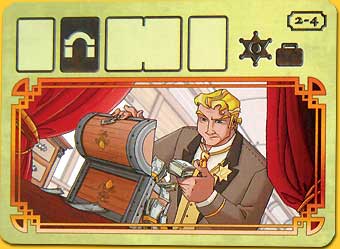 |
The number of cards that are to be played in a round is indicated by round card, which can also show special conditions for playing of some of the cards. Additionally, the round card can indicate that an event will happen at the end of the round, like shooting and movement by the Marshall. At the start of the game, the round cards are drawn from a deck of 7 possible cards, and are different for 2-4 and 5-6 players. When al action cards haven played, the current starting player takes the deck and performs the indicated actions as planned by the players for their bandit. At the end of the round, the player to the left of the current starting player becomes the new starting player and selects a new round card. |
|
|
| x |
|
|
|
|
|
|
|
|
|
|
|
|
|
|
|
|
|
|
|
|
|
|
|
|
|
|
|
|
|
|
|
|
|
|
|
|
|
|
|
|
|
|
|
|
|
|
|
|
|
|
|
|
|
|
|
|
|
|
|
|
|
| It is clear that the core of the game is formed by the actions that can be performed. Each player’s 10 actions cards give the possibility of executing 6 different actions. There are vertical movement cards that make it possible to move from the interior of a car to the roof, or back. Horizontal movement cards make it possible to move to an adjacent train car, when inside a train, or move a maximum of 3 cars when walking on the roof. With one of the two available robbery cards a loot token can be taken from a train card, and placed on the player’s character card. |
|
|
| x |
|
|
|
|
|
|
|
|
|
|
|
|
|
|
|
|
|
|
|
|
|
|
|
|
|
|
|
|
|
|
|
|
|
|
|
|
|
|
|
|
|
|
|
|
|
|
|
|
|
|
|
|
|
|
|
|
|
|
|
|
|
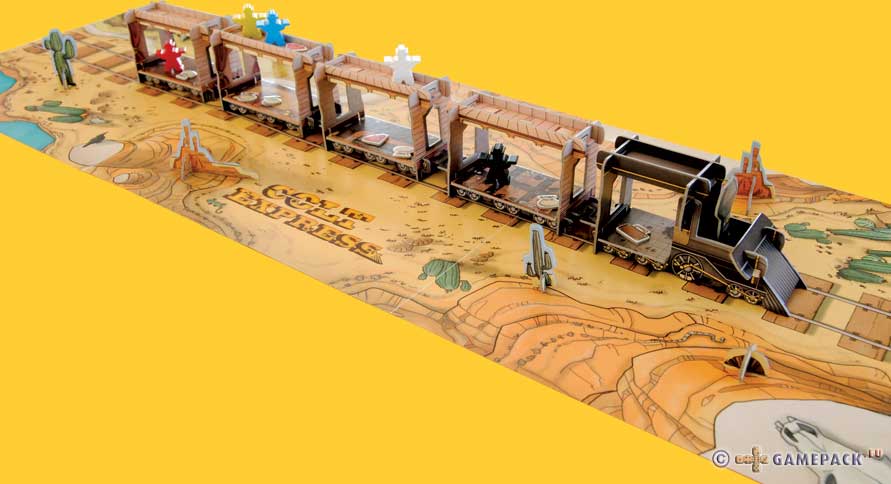 |
| x |
|
|
|
|
|
|
|
|
|
|
|
|
|
|
|
|
|
|
|
|
|
|
|
|
|
|
|
|
|
|
|
|
|
|
|
|
|
|
|
|
|
|
|
|
|
|
|
|
|
|
|
|
|
|
|
|
|
|
|
|
|
| The interaction is generated by the remaining action cards: the punch, fire and Marshal cards. With a punch card you punch a player who is in or on the same train car as yourself. As a consequence, the victim needs to drop one of this loot tokens on the spot and is moved to the same floor of an adjacent car by the attacker. To obtain this loot another robbery still has to be played. With a fire action it is checked whether the bandit playing this card can hit another bandit; when located inside a car this can only be a bandit in an adjacent car, but on the roof the bandits have full line of sight. The consequences of a hit are rather mild: a bullet card from the shooter is placed on top of the deck of action cards of the victim. Starting from the next round, these bullet cards may show up in the 6 actions cards, so too many hits will mess-up your action card deck. As a final action, the Marshal can be moved to adjacent train car (he never goes to the roof). When the Marshall enters a card where bandits are located, they immediately escape to the car’s roof, and are given a bullet card from a neutral bullet card deck. Besides messing-up the plans of other players, the Marshall can be moved to lure him away from the strongbox. |
|
 |
|
|
| x |
|
|
|
|
|
|
|
|
|
|
|
|
|
|
|
|
|
|
|
|
|
|
|
|
|
|
|
|
|
|
|
|
|
|
|
|
|
|
|
|
|
|
|
|
|
|
|
|
|
|
|
|
|
|
|
|
|
|
|
|
|
The actions of the players’ bandits are influenced by the special ability that each bandit has. As an example, Tuco is able to shoot through the roof to hit other bandits, and Ghost may play his first card of each round face-down, so no other player knows his first action. Each bandit has its own advantage, which may come in handy.
After 5 round the bandits count the value of their loot and the Gunslinger prize of 1000 dollar is awarded to the player(s) who shot the most bullets (played the most bullet cards). The richest player/bandit wins the game. |
|
|
| x |
|
|
|
|
|
|
|
|
|
|
|
|
|
|
|
|
|
|
|
|
|
|
|
|
|
|
|
|
|
|
|
|
|
|
|
|
|
|
|
|
|
|
|
|
|
|
|
|
|
|
|
|
|
|
|
|
|
|
|
|
|
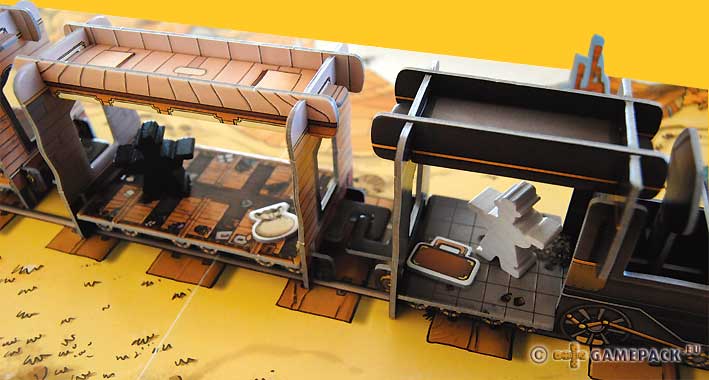 |
|
|
| x |
|
|
| x |
|
|
| x |
|
|
 |
|
|
|
|
|
|
|
|
|
|
|
|
|
|
|
|
|
|
|
|
|
|
|
|
|
|
|
|
|
|
|
|
|
|
|
|
|
|
|
|
|
|
|
|
|
|
|
|
|
|
|
|
| Colt Express is the kind of game where the excitement already starts as the game is placed on the table. Any game explanation need to wait until the players have played around a bit with the train and the bandit pawns and some Western movie quotes have been passed around the table. A bit comparable with games like A la Carte (imitation of the Swedish Chef, anyone?) or Ca$h ’n Gun$ (a Godfather quote, anyone?), where also an initial anarchy dominates the usually so disciplined game table. |
|
|
| x |
|
|
|
|
|
|
|
|
|
|
|
|
|
|
|
|
|
|
|
|
|
|
|
|
|
|
|
|
|
|
|
|
|
|
|
|
|
|
|
|
|
|
|
|
|
|
|
|
|
|
|
|
|
|
|
|
|
|
|
|
|
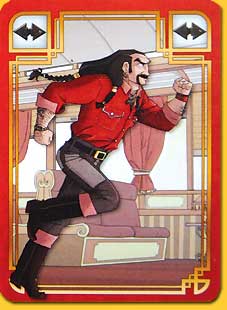 |
|
The atmosphere during the game is also comparable with the aforementioned games. It is possible to plan your actions, but they are most like disturbed by actions from other players, or your action options are limited due to too many bullet cards in your deck. When you can deal with kind of uncertainty, then a very nice, amusing game enfolds, with a lot of malicious delight in the failure of players’ actions, or their unexpected encounters with the Marshal. |
|
|
| x |
|
|
|
|
|
|
|
|
|
|
|
|
|
|
|
|
|
|
|
|
|
|
|
|
|
|
|
|
|
|
|
|
|
|
|
|
|
|
|
|
|
|
|
|
|
|
|
|
|
|
|
|
|
|
|
|
|
|
|
|
|
Thematically, it may sound a bit aggressive, but it’s the same kind of aggressiveness when playing cowboys and Indians as a child: bang-bang your are dead!, and the next thing, everybody stands up and walks way. Moreover, such a politician incorrect theme is a nice change from the now so common solid Eurogames where silently the players shove their wooden chits back and forth.
A game of Colt Express tells a small Western tale and it often leads to discussions afterwards: “If you hadn’t punched, I would have been able to ....”. |
|
|
| x |
|
|
|
|
|
|
|
|
|
|
|
|
|
|
|
|
|
|
|
|
|
|
|
|
|
|
|
|
|
|
|
|
|
|
|
|
|
|
|
|
|
|
|
|
|
|
|
|
|
|
|
|
|
|
|
|
|
|
|
|
|
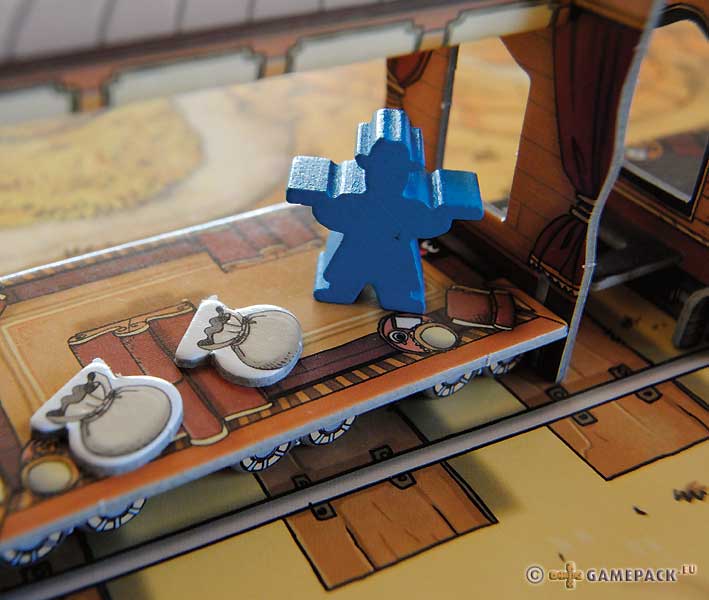 |
|
|
| x |
|
|
|
|
|
|
|
|
|
|
|
|
|
|
|
|
|
|
|
|
|
|
|
|
|
|
|
|
|
|
|
|
|
|
|
|
|
|
|
|
|
|
|
|
|
|
|
|
|
|
|
|
|
|
|
|
|
|
|
|
|
This nice atmosphere is only encouraged by the graphical design, with as climax the terrific 3D train, which, not unimportant, also fits excellently in the box. Add to this a swift playing time of around 30 minutes, and it is clear that Colt Express is highly recommended for those who are looking for a good start or final game for a gaming session. And, to add to the atmosphere, put on some Ennio Morricone music!
© 2014 Edwin van de Sluis
Colt Express, Christophe Raimbault, Ludonaute/Asmodee, 2014 - 2 to 6 players, 10 years and up, 40 minutes
|
|
|
  |
|
|
|
|
|
|
|
|
|
|
|
|
|
|
|
|
|
|
|
|
|
|
|
|
|
|
|
|
|
|
|
|
|
|
|
|
|
|
|
|
|
|
|
|
|
|
|
|
|
|
|
|
  |
|
|
|
|
|
|
|
|
|
|
|
|
|
|
|
|
|
|
|
|
|
|
|
|
|
|
|
|
|
|
|
|
|
|
|
|
|
|
|
|
|
|
|
|
|
|
|
|
|
|
|
|
  |
Party games, bleh... |
|
|
|
|
|
|
|
|
|
|
|
|
|
|
|
|
|
|
|
  |
|
|
|
|
|
|
|
|
|
|
|
|
|
|
|
|
|
|
|
|
|
|
|
|
|
|
|
|
|
|
|
|
|
|
|
|
|
|
|
|
|
|
|
|
|
|
|
|
|
|
|
|
| x |
|
|
|
|
|
|
|
|
|
|
|
|
|
|
|
|
|
|
|
|
|
|
|
|
|
|
|
|
|
|
|
|
|
|
|
|
|
|
|
|
|
|
|
|
|
|
|
|
|
|
|
|
|
|
|
|
|
|
|
|
|
| x |
|
|
|
|
|
|
|
|
|
|
|
|
|
|
|
|
|
|
|
|
|
|
|
|
|
|
|
|
|
|
|
|
|
|
|
|
|
|
|
|
|
|
|
|
|
|
|
|
|
|
|
|
|
|
|
|
|
|
|
|
|
 |
|
|
|
|
|
|
|
|
|
|
|
|
|
|
|
|
|
|
|
|
|
|
|
|
|
|
|
|
|
|
|
|
|
|
|
|
|
|
|
|
|
|
|
|
|
|
|
|
|
|
|
|
 |
|
|
|
|
|
|
|
|
|
|
|
|
|
|
|
|
|
|
|
|
|
|
|
|
|
|
|
|
|
|
|
|
|
|
|
|
|
|
|
|
|
|
|
|
|
|
|
|
|
|
|
|
| x |
|
|
|
|
|
|
|
|
|
|
|
|
|
|
|
|
|
|
|
|
|
|
|
|
|
|
|
|
|
|
|
|
|
|
|
|
|
|
|
|
|
|
|
|
|
|
|
|
|
|
|
|
|
|
|
|
|
|
|
|
|
 |
|
|
|
|
|
|
|
|
|
|
|
|
|
|
|
|
|
|
|
|
|
|
|
|
|
|
|
|
|
|
|
|
|
|
|
|
|
|
|
|
|
|
 |
|
|
|
|
|
|
|
|
|
|
|
|
|
|
|
|
|
|
|
|
|
|
|
|
|
|
|
|
|
|
|
|
|
|
|
|
|
|
|
|
|
|
|
|